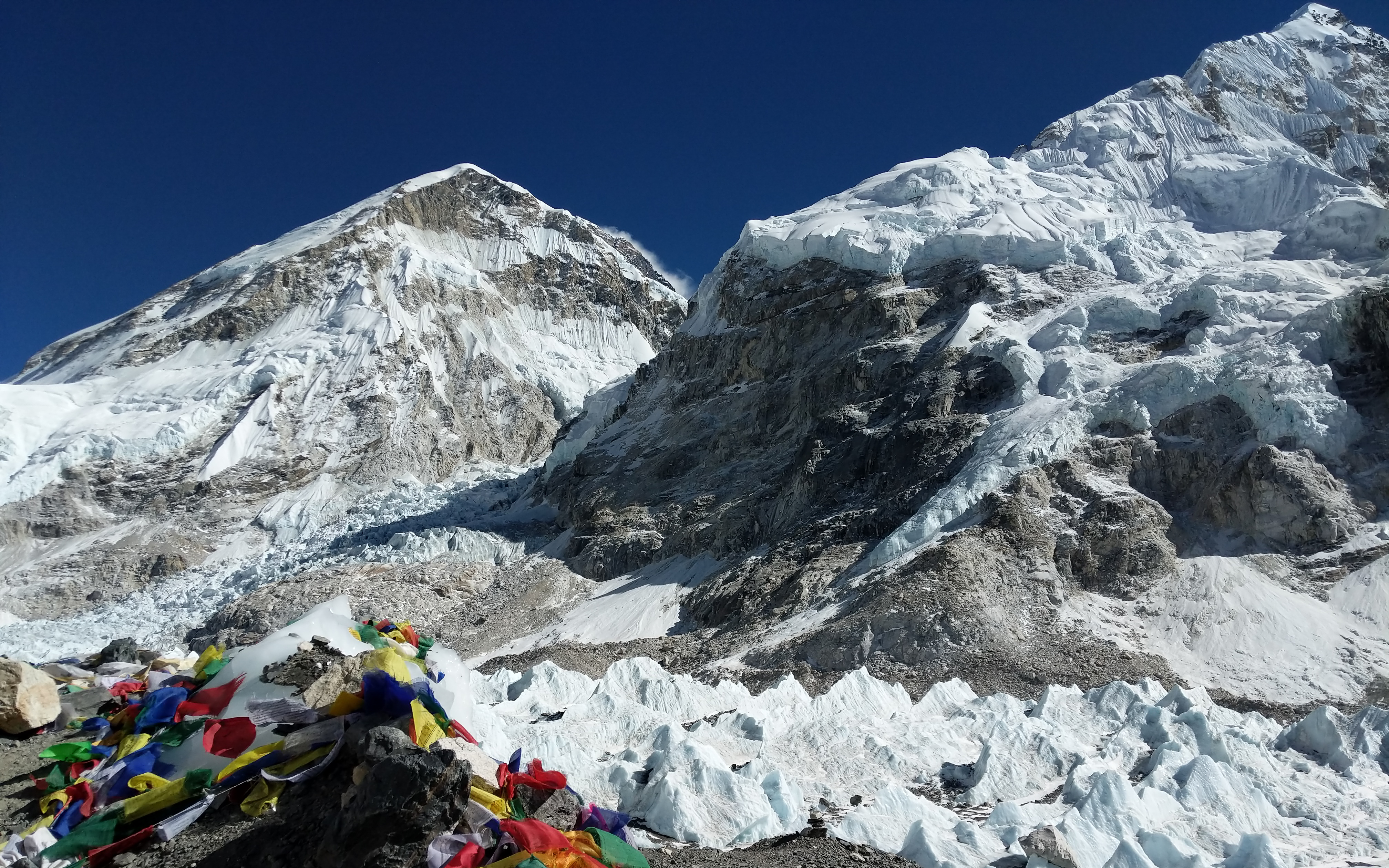
"I like the mountains because they make me feel small,' Jeff says. 'They help me sort out what's important in life." - Mark Obmascik, Halfway to Heaven
After our experience in Patagonia and stories of Annapurna circuit from Alejandro, Shrey (15 at the time) and I started to toy with the idea of going to the Everest Base Camp (EBC).
At the beginning it seemed like a far-fetched idea which was way too difficult but slowly, as we read more we started to believe that it was doable.
A serendipitous chat with a friend helped us identify a great outfitter, Yeti Mountain Homes and they arranged for nearly everything other
than the flights to Kathmandu. They are super-efficient in their communications and were able to quickly provide us with the best possible plan for our trip.
This was the original trekking plan that YMH shared and it was supposed to be a 14-15-day trek if everything was ok. And it is a big if.
As we came to know later, everything in Nepal is highly unpredictable, weather being the biggest one. In the mountains weather can play spoilsport at every turn.
And that was possibly the only positive of going on the trek in December except maybe the fact that it is also the low season and you are not fighting for rooms at the tea houses during the trek.
Yes, we did this trek in the dead of the winter from December 23, 2018 to Jan 4, 2019 reaching the base camp on New Year's Eve.
We kind of knew what we were getting into and were well prepared but still when the Garmin showed -29F inside the tea house, we did question our decision a few times.
That said, whenever I go back to the region, I will do so in the winter.
Note: There are multiple English spellings of the places on the trek. Keeping to the spirit of Lens and Atlas, I have spelled them all to how they are spelled on the Google Map above for easy reference.
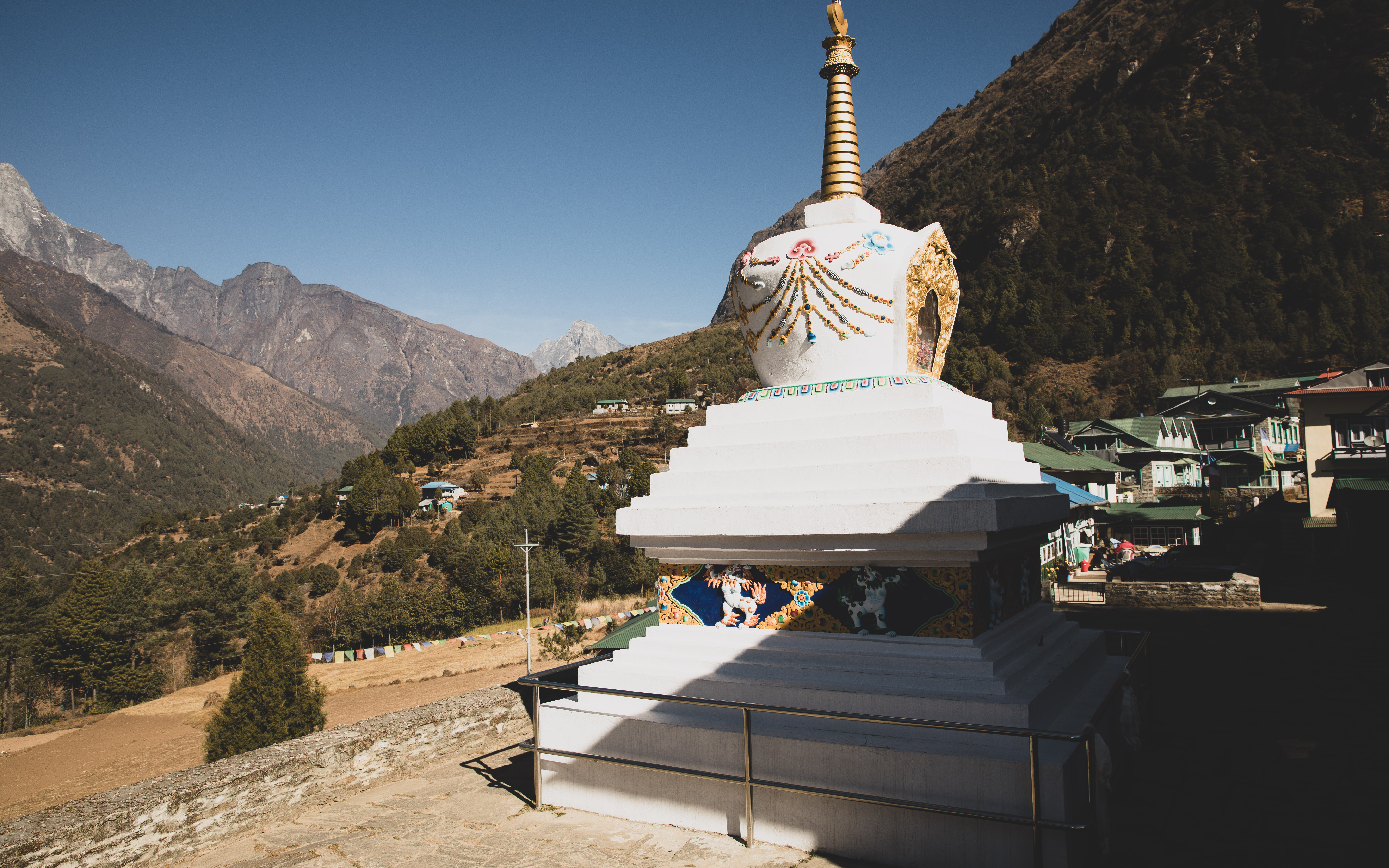 The Everest Base Camp trek is a village to village trek. Small villages dot the 40 odd miles from Lukla to the base camp forming the supply chain conduit for climbers attempting the
tallest peak on earth. Basically, you start your trek early in the morning, walk for around 5-6 hours till you reach the next village, check in to a lodge or tea house, eat dinner,
sit around a fire, rinse and repeat. Accommodations are decent up to Namche Bazaar but beyond once you get in the Khumbu valley, the tea houses are very basic. Made of plywood with corrugated
roof they offer basic food, toilet facilities and some protection from the elements. While most Everest climbers attempt to summit during the spring season, EBC is open most of the year to trekkers
except for the rainy season when the trail is not very stable. The trail is well marked and populated and can be attempted without any help, we did have our guide and porter.
The Everest Base Camp trek is a village to village trek. Small villages dot the 40 odd miles from Lukla to the base camp forming the supply chain conduit for climbers attempting the
tallest peak on earth. Basically, you start your trek early in the morning, walk for around 5-6 hours till you reach the next village, check in to a lodge or tea house, eat dinner,
sit around a fire, rinse and repeat. Accommodations are decent up to Namche Bazaar but beyond once you get in the Khumbu valley, the tea houses are very basic. Made of plywood with corrugated
roof they offer basic food, toilet facilities and some protection from the elements. While most Everest climbers attempt to summit during the spring season, EBC is open most of the year to trekkers
except for the rainy season when the trail is not very stable. The trail is well marked and populated and can be attempted without any help, we did have our guide and porter.
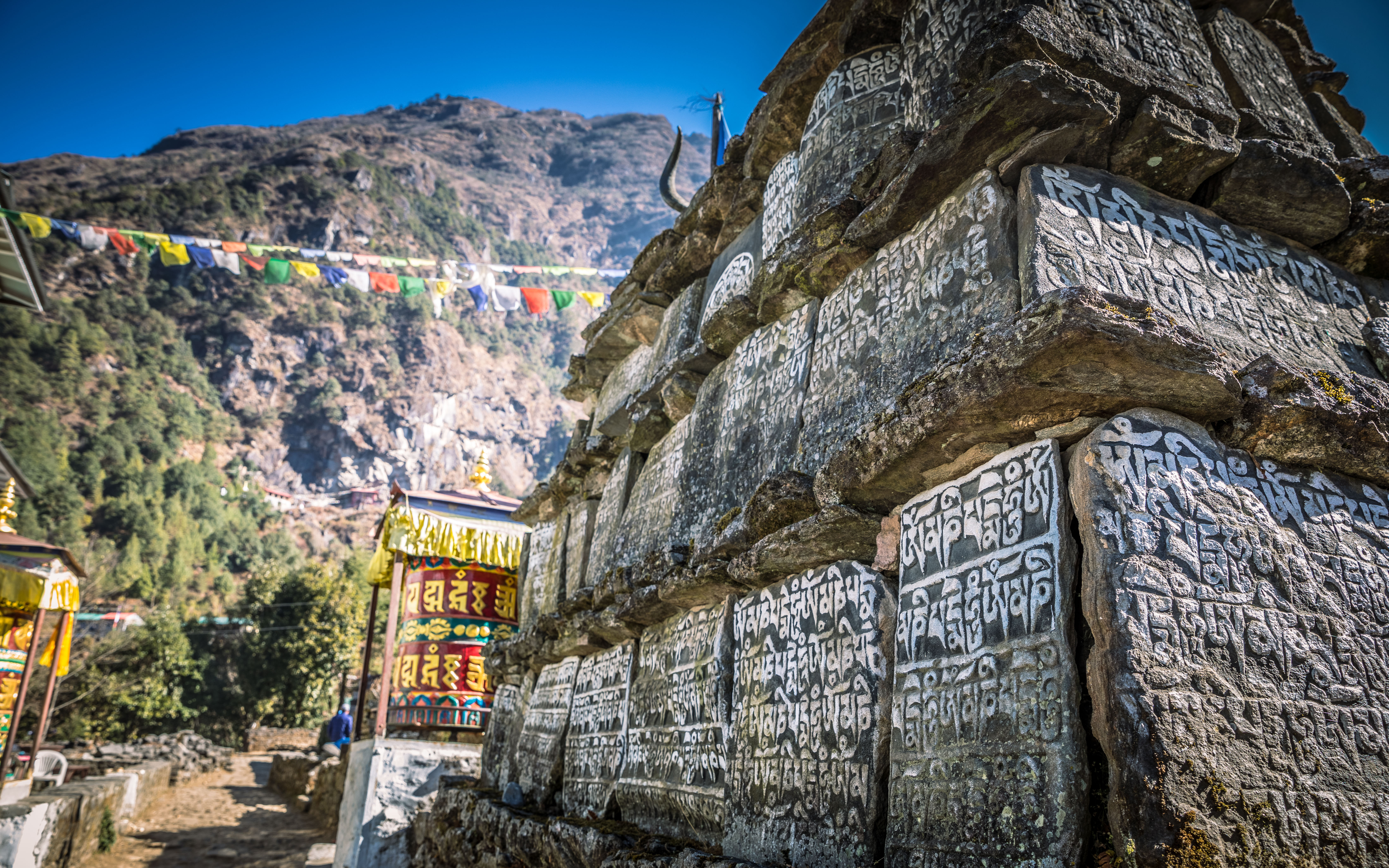 That brings us to the ethics of climbing with the help of Sherpas. First, let it be very clear, no one can climb in the Everest region without help from the Shrepas.
I mean no one. It is possibly the harshest conditions that one can encounter in any part of the world and while one can trek without their help, the village infrastructure is supplied by
the hardworking porters who carry ungodly amounts of weight in the form of propane cylinders, plywood, corrugated sheets and grocery, walking miles wearing flimsy crocs. So, you are getting
their help one way or the other. On the other hand, the region also depends heavily on the revenues from climbers and trekkers; guide and porter jobs pay better than most others. When it comes
to climbing the Everest, of course there are risks for the porters and Sherpas. And they share a disproportionately high amount of it laying ropes, putting ladders over crevices and hauling oxygen
cylinders. But as long as the allure of the mountains attract climbers and trekkers the economics and the ethical debate are here to stay. On our part, we must respect the local traditions,
go through reputed agencies, be awed by these super humans and be fascinated by this egalitarian community of brave hearts who choose to name themselves on the days of the week. Peter Zukerman
and Amanda Padoan's fascinating book "Buried in the Sky" is a must
read and an eye opening guide to the world of Sherpas and other communities who work in high altitudes to make a living.
That brings us to the ethics of climbing with the help of Sherpas. First, let it be very clear, no one can climb in the Everest region without help from the Shrepas.
I mean no one. It is possibly the harshest conditions that one can encounter in any part of the world and while one can trek without their help, the village infrastructure is supplied by
the hardworking porters who carry ungodly amounts of weight in the form of propane cylinders, plywood, corrugated sheets and grocery, walking miles wearing flimsy crocs. So, you are getting
their help one way or the other. On the other hand, the region also depends heavily on the revenues from climbers and trekkers; guide and porter jobs pay better than most others. When it comes
to climbing the Everest, of course there are risks for the porters and Sherpas. And they share a disproportionately high amount of it laying ropes, putting ladders over crevices and hauling oxygen
cylinders. But as long as the allure of the mountains attract climbers and trekkers the economics and the ethical debate are here to stay. On our part, we must respect the local traditions,
go through reputed agencies, be awed by these super humans and be fascinated by this egalitarian community of brave hearts who choose to name themselves on the days of the week. Peter Zukerman
and Amanda Padoan's fascinating book "Buried in the Sky" is a must
read and an eye opening guide to the world of Sherpas and other communities who work in high altitudes to make a living.
So how did we prepare for the climb? I planned a lot! My son brought his amazing spirit and grit to the party.
I kept thinking of upping my fitness game. My son was swimming or cycling miles a day.
But it took an entire year of planning and procrastinating on my fitness goals for us to get ready. A question everyone asks me is "do you need to be super fit to trek to the EBC?".
I would say, one needs to be in decent shape to do the trek. But not necessarily marathon fit. I saw many fellow trekkers who were super fit succumb to altitude sickness,
or eating something disagreeable and falling sick, or just mentally giving up on the last leg. One thing I did realize was that EBC and similar other hard treks are equal part
a mental and physical challenge. Acute mountain sickness is a real problem and it can hit anyone at any point. Shrey did get a bout of it the night before our climb to EBC but did
recover from it by daybreak, which I felt was a sheer mind over matter feat for him. Doing some test climbs on some accessible peaks is a good way to test how your body might react
to the altitude.
 We climbed a few 14ers in Colorado in the month of August. But they are just a good test and not a guarantee that if you did not get sick there you will not at EBC.
So be prepared, drink a lot of water and most importantly keep enough acclimatization days in the plan.
We climbed a few 14ers in Colorado in the month of August. But they are just a good test and not a guarantee that if you did not get sick there you will not at EBC.
So be prepared, drink a lot of water and most importantly keep enough acclimatization days in the plan.
Doing the trek in the dead of winter increases the difficulty multiple fold but it is also something that good gear can solve to a large extent.
There are certain items - sleeping bags, down jackets and socks that I would not skimp on and there are some things I wish I was not carrying at all!
This is our packing list, take it as a reference but do your own research. And look for bargains. We had our list ready at the very beginning but waited months for good deals
to make the actual purchase. Happy shopping.
Finally, about photography before we dive into the details of the actual trek. The trip to EBC was the opportunity of a lifetime for me to take photos
and I had big hopes to get some stunning shots of the mountains, golden peaks, endless valleys, night skies and the mighty yaks. Even being very pragmatic and
not carrying even the tripod, I had severely underestimated the weight of a Canon 5D IV with a wide-angle lens or I had severely overestimated by ability to lug it on the Nepali flat.
I had to ditch the SLR just after two days at the last YMH lodge from where I could pick it up on return. I also severely overestimated the capability of my GoPro HERO 6 and its battery
to operate in freezing temperatures. A combination of these factors ensured that I was left with my Pixel 2 for all the photos that you see. But as they say, the best camera is the
one that you have when you need it. So do plan well for the gear you want to carry to a trip like this including figuring out how you will charge them or keep them from
draining out of juice in freezing cold. Most tea houses charge approximately USD 10 for an hour of charging any device.
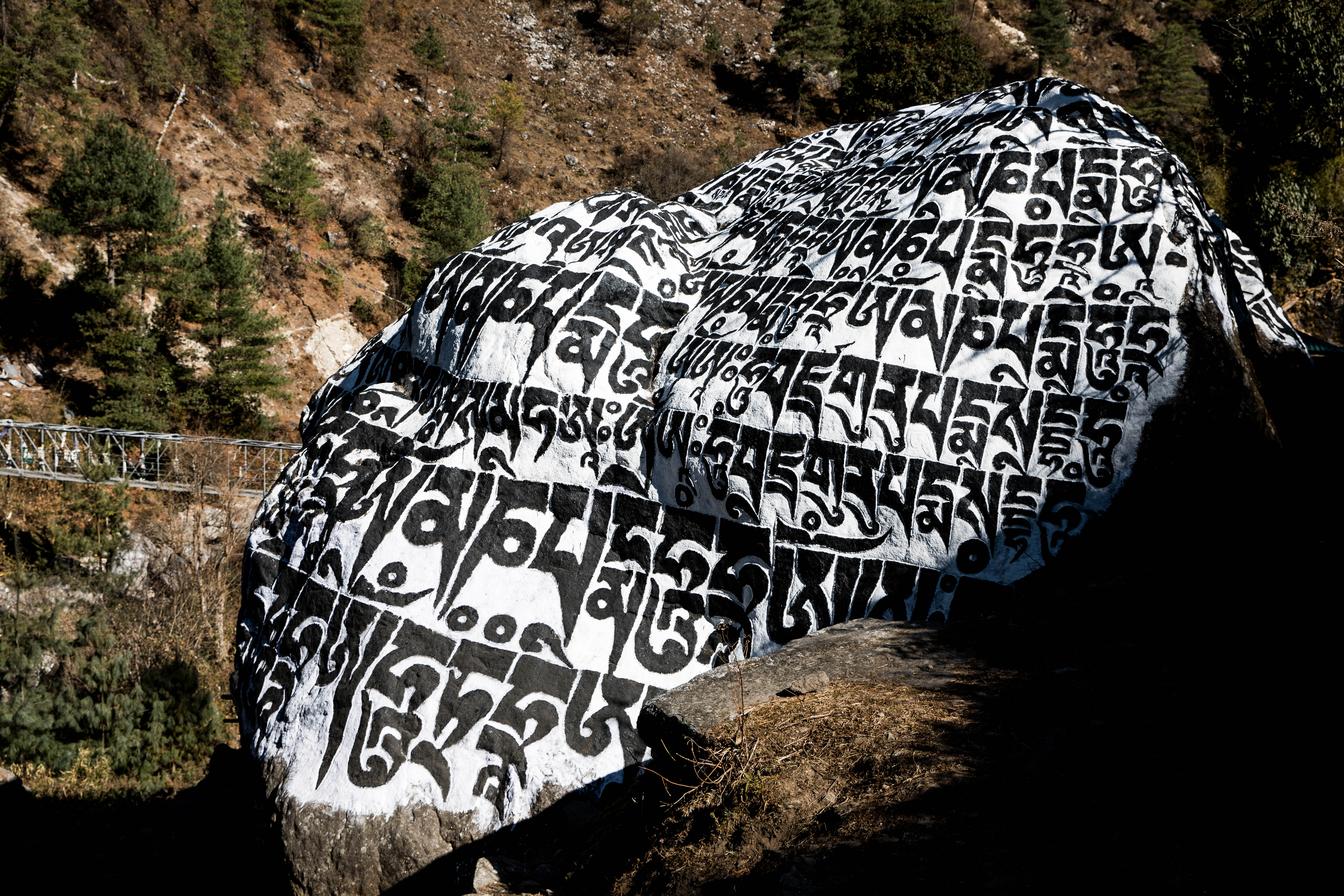 The long evenings in the tea houses gave ample time to write down about the day in the diary and that is what the rest of this account is. I would jot down things I wanted to remember
every day, at least every day we were trekking up. I did not write much during the three ways we descended back to Lukla. But probably I did not need to. We did this trip in
December 2018 - January 2019 and I am putting together the Nepal page only when we are locked up amidst a global pandemic (yes, this is May 2020) and each memory is clear
as if it happened just last week. I believe that when you go through an intense experience it burns itself in your memory. I often find myself typing ahead sentences that I find
later written in the diary. It is an amazing feeling and reaffirms my belief that we need to slow down to feel more, love more and live more.
The long evenings in the tea houses gave ample time to write down about the day in the diary and that is what the rest of this account is. I would jot down things I wanted to remember
every day, at least every day we were trekking up. I did not write much during the three ways we descended back to Lukla. But probably I did not need to. We did this trip in
December 2018 - January 2019 and I am putting together the Nepal page only when we are locked up amidst a global pandemic (yes, this is May 2020) and each memory is clear
as if it happened just last week. I believe that when you go through an intense experience it burns itself in your memory. I often find myself typing ahead sentences that I find
later written in the diary. It is an amazing feeling and reaffirms my belief that we need to slow down to feel more, love more and live more.
We had planned the trip in a way that Shrey and I will travel to India and then to Nepal directly and we will meet back with family on our return to Delhi. We flew via Dubai which is kind of also my regular business travel stopover, therefore it is always a blur of get in the plane, go to the lounge in Dubai, get on the next flight and land in Delhi, watch a whole bunch of movies on the way and try to enjoy the airline food. This time there was the added step of a layover in Delhi and getting on another flight from Delhi to Kathmandu. Since there was about 8 hours of layover in Delhi, we were looking for options for a quick shower and shut eye and came across the Holiday Inn which is supposedly a transit hotel inside the IGI airport. But there are two of them, international and national and you are supposed to book the one that matches your departing flight. Therefore, we booked the International one, only to realize after coming out through customs and immigration that we cannot go back to the International one since it was 2 AM and it opens only at 6 AM or so. Tired and frustrated, I tried using my Marriott Lifetime Titanium status and viola, we had a limousine pick us up and we were whisked to the Aloft in Aero City within 30 mins. We could get a few hours of sleep. It is like any other Aloft, but the breakfast was amazing, and we were dropped off in a hotel car back to the airport. The flight from Delhi to Kathmandu is a quick two and a half hours. We spent a normal amount of time at immigration and customs in Kathmandu but overall it is pretty smooth.
I was born in a village 50 kilometers from the Nepal border and Kathmandu was the first real taste of a 'foreign' city for me. And for the child in me it held the charm of
a far-off exotic land where I had encountered mystic Hindu pagodas, manicured royal gardens and those fancy Japanese Toyota Corollas for the very first time. This was probably when I was in
elementary or middle school. Nepal has since descended into its own chaos of Maoist insurgency, murder of the Royal family, earthquakes followed by a spiraling economy and all of it has taken its
toll on the nation. Add to that the pressures of development carried by probably the only big city in the country, Kathmandu seems to have transformed into a grotesque version of its glorious past. A layer
of dust and apathy seems to have settled onto this city of my childhood dreams.
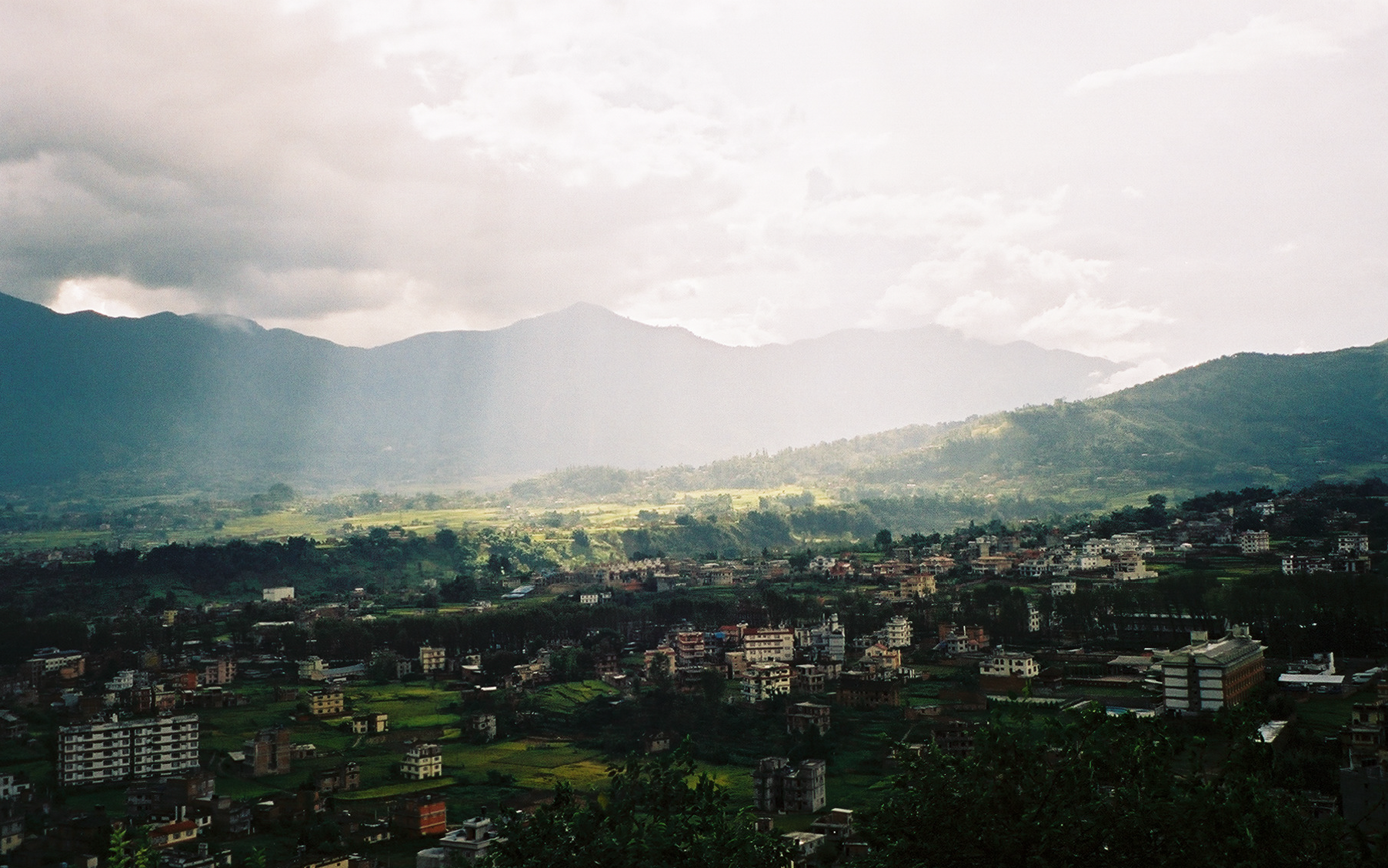 This picture was taken the last time I was here in 2001, and the intervening 18 years or so have further pockmarked and scarred the city.
I still fervently hope that someday, someone will rise and save this beautiful jewel.
This picture was taken the last time I was here in 2001, and the intervening 18 years or so have further pockmarked and scarred the city.
I still fervently hope that someday, someone will rise and save this beautiful jewel.
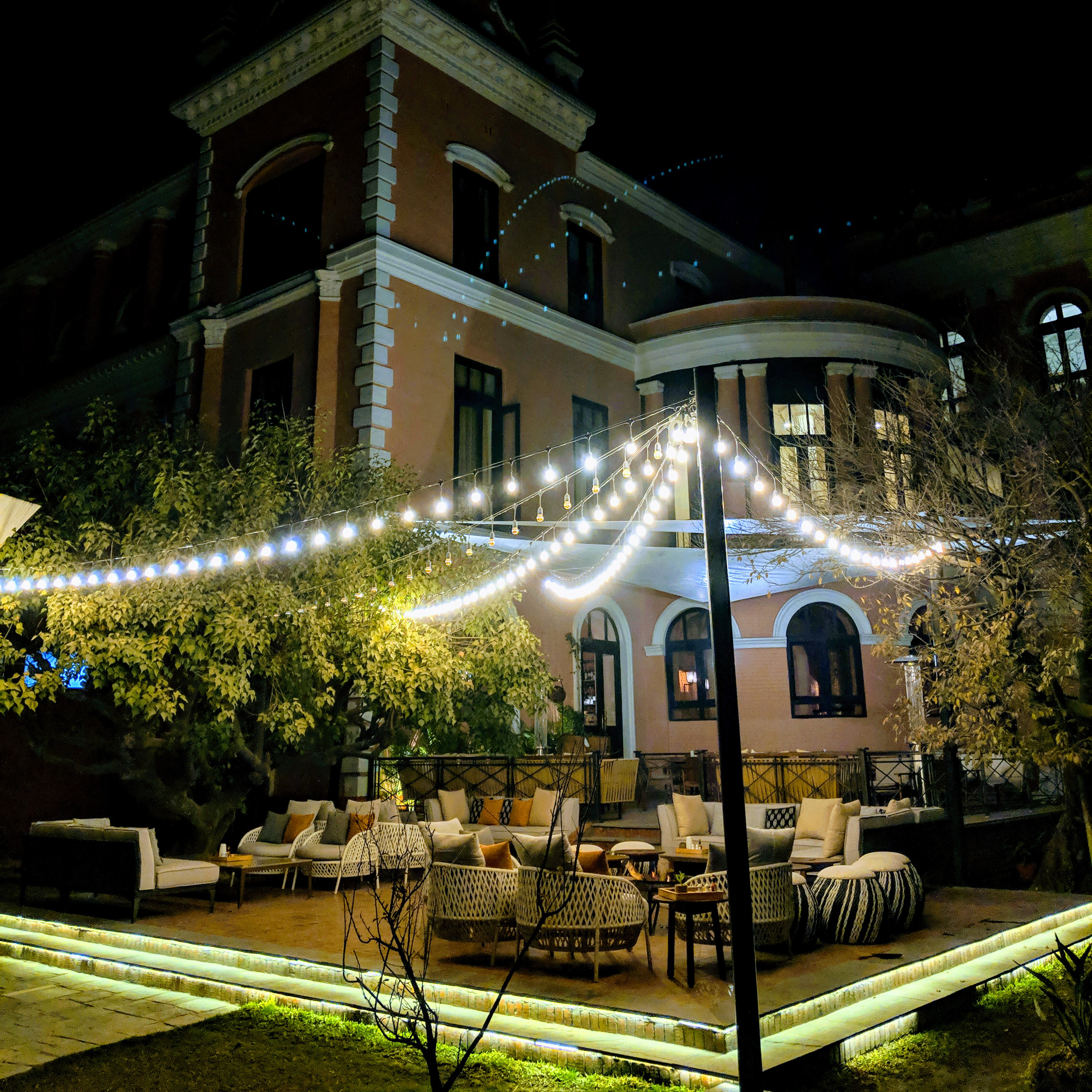 We had one evening stay at the Yak and Yeti a pretty decent hotel under the circumstances.
It reminded me of the Melia at Iguazu.
Both the hotels trying to hang on to their glorious past and struggling.
We had one evening stay at the Yak and Yeti a pretty decent hotel under the circumstances.
It reminded me of the Melia at Iguazu.
Both the hotels trying to hang on to their glorious past and struggling.
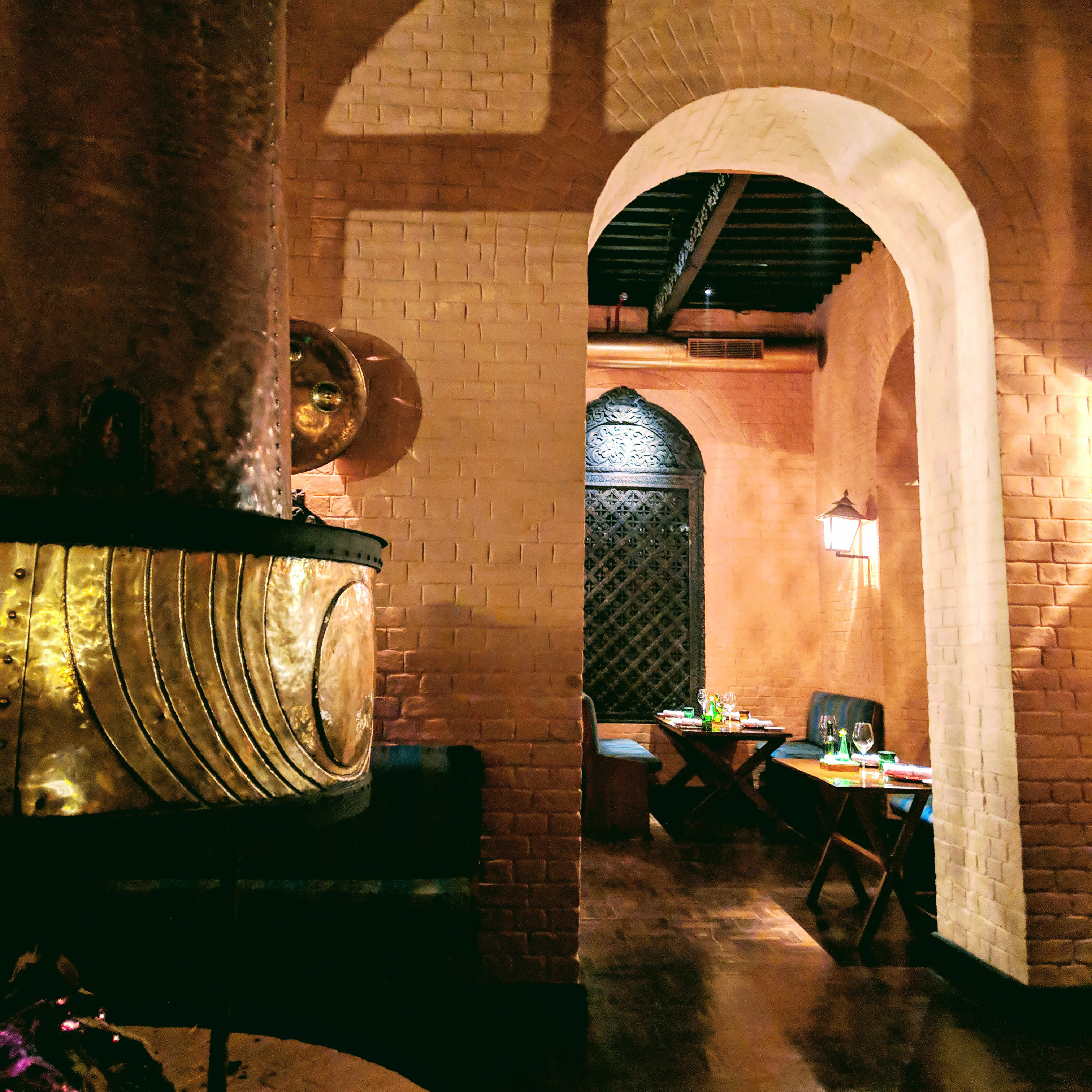 Dinner at their signature restaurant Chimney was the bright spot though. We feasted on some Kababs, French onion soup
which was the star, momos which were just okay and Gurkha beer. Of course, this was the last time I was having any beer
before we got on the tough climb. I am really hoping to get some more on our way back.
Dinner at their signature restaurant Chimney was the bright spot though. We feasted on some Kababs, French onion soup
which was the star, momos which were just okay and Gurkha beer. Of course, this was the last time I was having any beer
before we got on the tough climb. I am really hoping to get some more on our way back.
That evening we were met by our guide Tanzing Sherpa. He came to the hotel to hand us the duffels pack our stuff so that we can leave our large suitcases in the hotel, making sure we only packed 15 kilos in each duffle which were to be hauled up the mountain by our incredible porter – Phurba Sherpa. More about him later.
Anything above the 15 kilos had to go in backpacks that we carried on our own or were staying back. We had planned for this pretty well so redistributing the gear was quick.
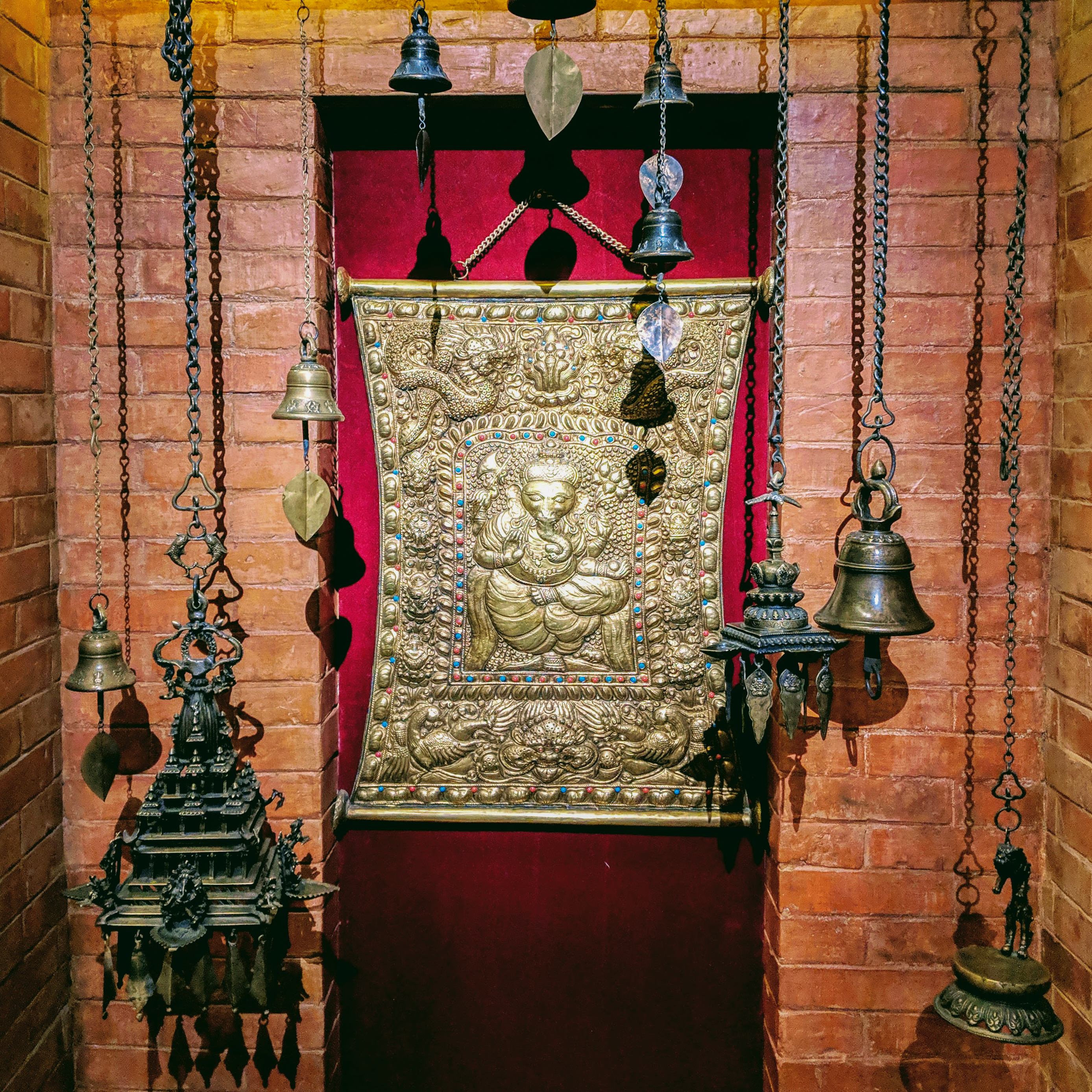 Coming back to Tanzing, he has world view formed through the lens of social media and talking to travelers and trekkers. He is very very knowledgeable and had a point of view on everything. As a young representative of the
community he has an acute awareness of politics in the country and around. But that is how you get when you meet so many people. We have
stayed connected since then and one day I am sure we will meet again.
Coming back to Tanzing, he has world view formed through the lens of social media and talking to travelers and trekkers. He is very very knowledgeable and had a point of view on everything. As a young representative of the
community he has an acute awareness of politics in the country and around. But that is how you get when you meet so many people. We have
stayed connected since then and one day I am sure we will meet again.
| From | Lukla |
| To | Monjo |
| Starting Elevation | 2,800 mts. |
| Ending Elevation | 2,800 mts. |
| Elevation Gain | +200, -200 |
| Distance | 13 kms. |
| Time Taken | 6 hrs. |

We started from Yak and Yeti very early in the morning since we were supposed to be on a 7:00 AM flight to Lukla.
The flight was surprisingly on time but strong winds in Lukla forced us to the take a detour and we landed at a small airport. A thing about these
airplanes, they are more like small buses with wings. You just scoot inside and pray that they land safely. Lukla is the world's most dangerous airport. The
planes land on a tiny airstrip carved on the side of a cliff with absolutely no margin for error. Our flight was full, but we were surprised that none of the passengers were going to EBC.
A few were trekking locally till Namche Bazar. The left side of the plane is the best for some early view of the mountains.
One great benefit of traveling with Yeti Mountain Homes is that they own the best properties on the EBC trail up to Namche Bazaar.
That makes the lunch stops and night stays for the first third of the trip super luxurious and we did need some of that pampering
at least on our way back. After landing in Lukla, we made a small tea break at the YMH hotel in Lukla, got the first taste
of ginger tea that would become sustenance very soon on the trail, filled up our water bottles and started the trek. The trek starts from a very non-descript part of Lukla.
Tanzing got us the permits from the local office, and Phurba loaded up our bags along with his own and Tanzing’s and off we went.
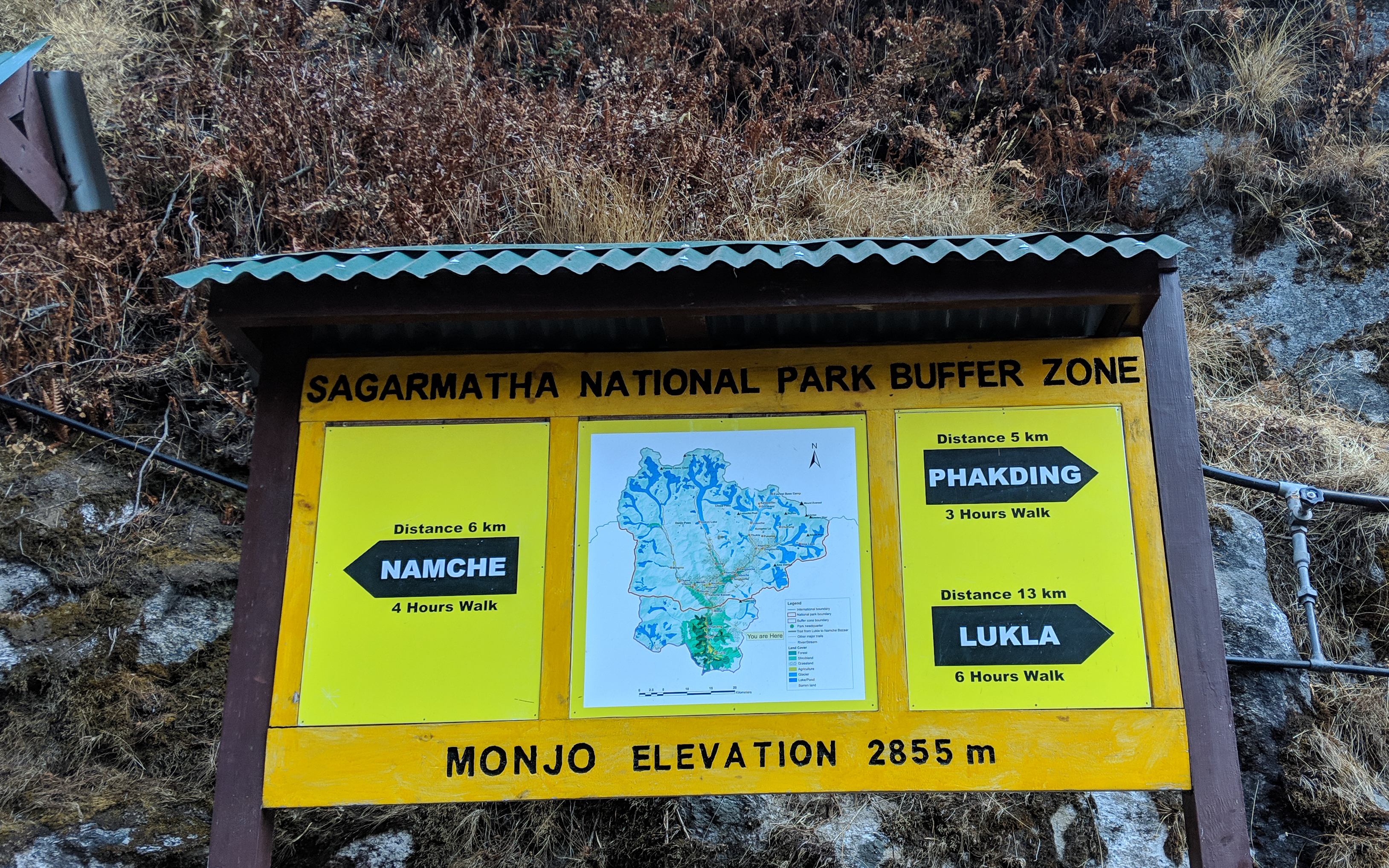 The first day trek is basically climbing down two hundred meters to Phakding then 200 meters up to Monjo. We soon realized why people here refer to distances in time rather than miles.
Because they are just relative on your level of physical fitness and I started to curse not having been on the stair climber at Lifetime longer.
The first day trek is basically climbing down two hundred meters to Phakding then 200 meters up to Monjo. We soon realized why people here refer to distances in time rather than miles.
Because they are just relative on your level of physical fitness and I started to curse not having been on the stair climber at Lifetime longer.
 The first day trek itself is beautiful along the Doodh Kosi river which gets its name from the milky foam from melting glaciers up above.
Interestingly all the mountains you first encounter do not have names since anything below 6000 meters does not even deserve to get a name in this valley of titans.
It felt chilly at the start of the day, but it got hot very quickly. We met first a few fellow trekkers who were soon to become familiar faces on the journey.
The first day trek itself is beautiful along the Doodh Kosi river which gets its name from the milky foam from melting glaciers up above.
Interestingly all the mountains you first encounter do not have names since anything below 6000 meters does not even deserve to get a name in this valley of titans.
It felt chilly at the start of the day, but it got hot very quickly. We met first a few fellow trekkers who were soon to become familiar faces on the journey.
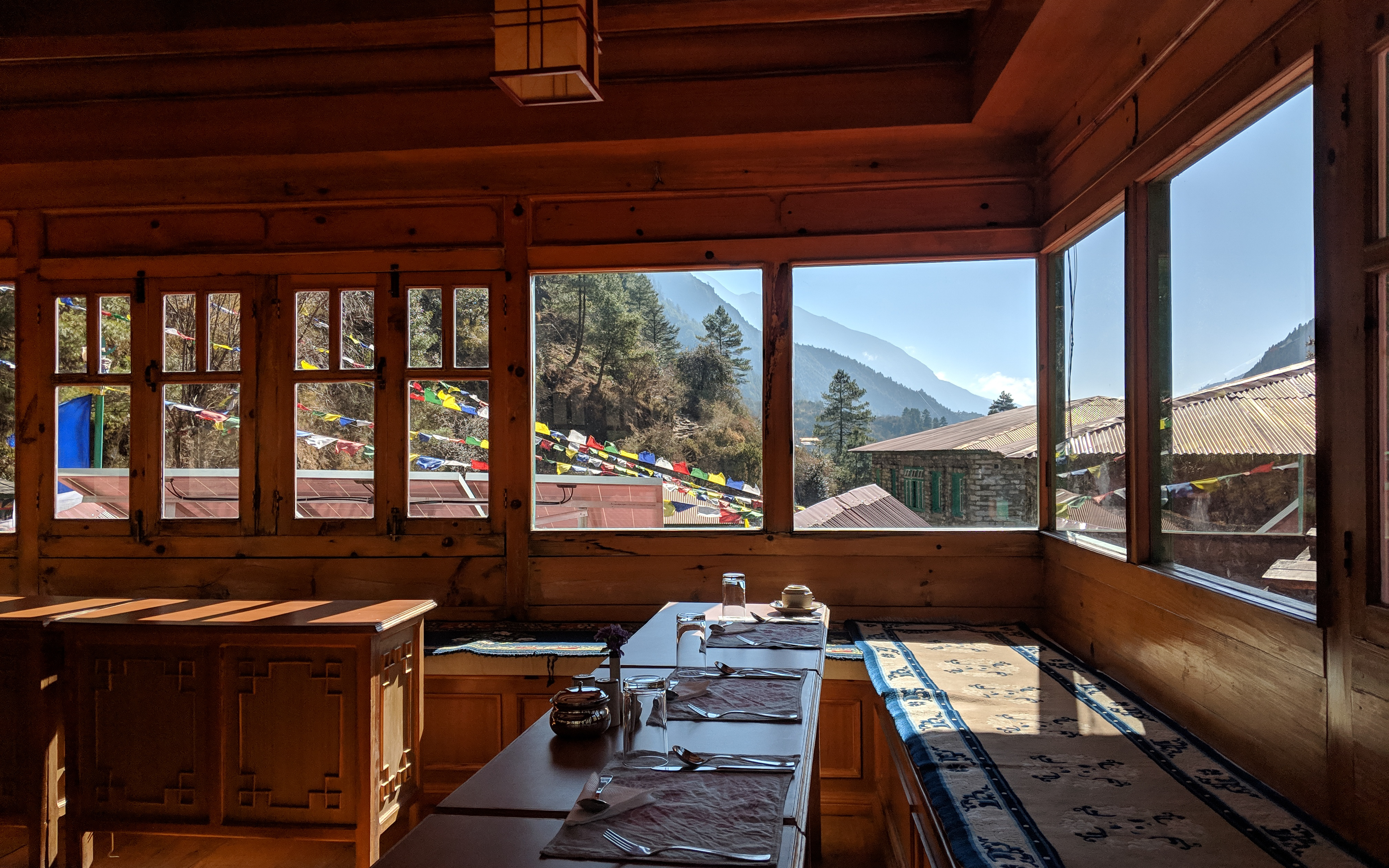 By afternoon we reached the amazing facilities of YMH in Phakding, where we had a lunch of noodles with eggs and another dose of the ginger tea with hot water.
By afternoon we reached the amazing facilities of YMH in Phakding, where we had a lunch of noodles with eggs and another dose of the ginger tea with hot water.
The last few kilometers before you get into Monjo are a brutal climb. My legs started to cramp, and I had to slow down. I should be hydrating more from here.
We reached Monjo at around 4:00 PM and checked into another beautiful YMH property. We came in the room and were instantly shivering. The setting sun just drains the valley of
any warmth and it sinks into a bitter cold, something we will start of dread as we move forward. Dinner was at 7:30 but Shrey did not want to get out of bed since he was so cold.
And to add to the misery we did not even realize that there were heated blankets and ended up shivering all night.
Dinner was boiled vegetables, chicken and fried rice and discussion with Tanzing was about Cordyceps which
are these weird parasitic fungus that grows inside a caterpillar. We shared our stories of love for the mountains all over the world and then drifted off to sleep through
the jet lag till the next day.
The cramp on the climb to Monjo is making me think if the huge camera is a bad decision, I am second guessing myself.
| From | Monjo |
| To | Namche Bazaar |
| Starting Elevation | 2,800 mts. |
| Ending Elevation | 3,460 mts. |
| Elevation Gain | +660 |
| Distance | 6 kms. |
| Time Taken | 3 hrs. |
We did not dare to shower this morning; the night was freezing so we stuck to wipes only. Had an early breakfast at 7:30 AM which was porridge (yum), omelet, bread and coffee.
I moved some of the camera gear from my personal bag to Shrey, I was dreading the 600 meters of climb today, specially with the thinning air. But the shoulder bag still feels heavy.
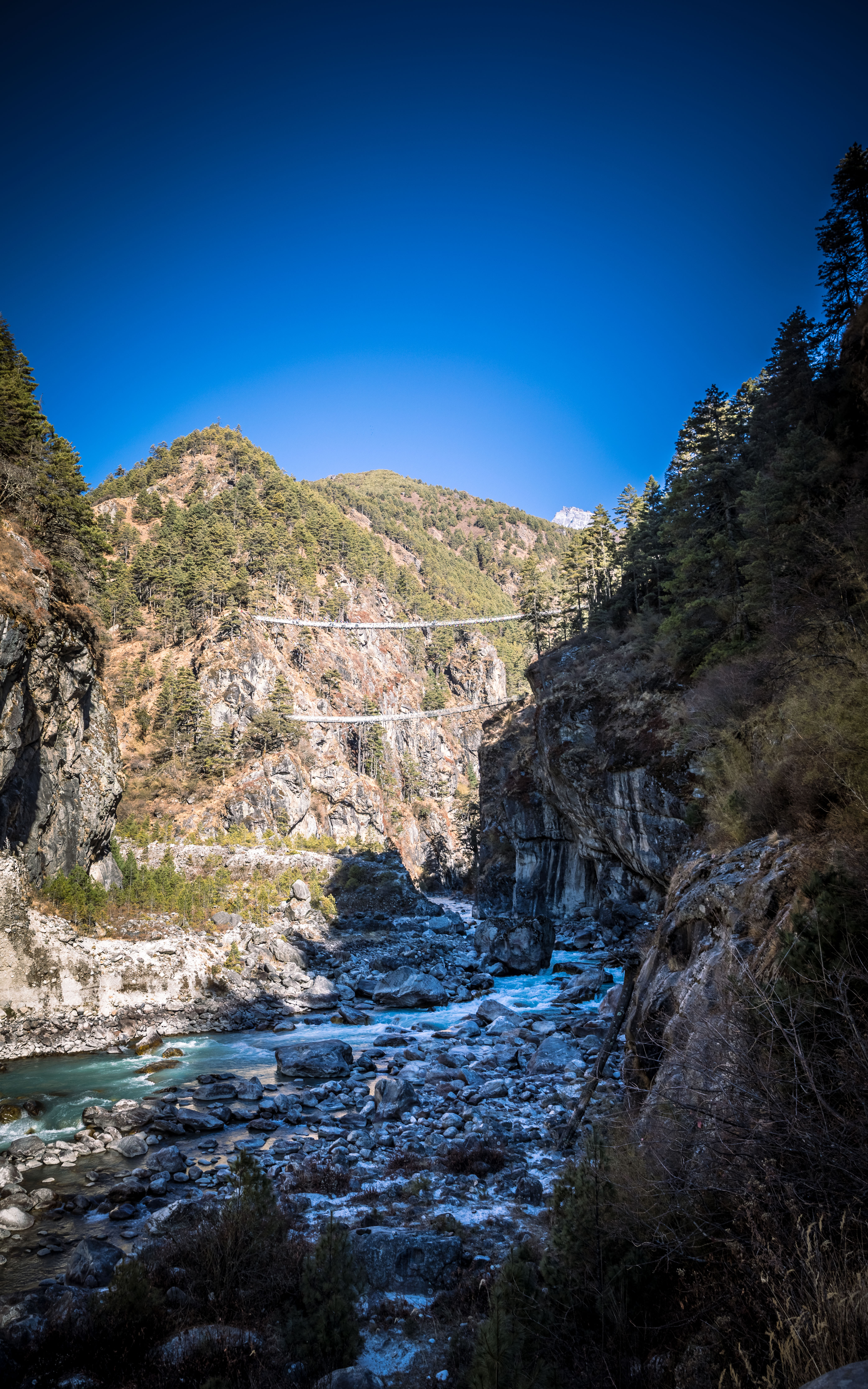 The trek again follows Doodh Kosi and it crisscrosses many bridges before getting into Namche.
One of them is the "Two Peak Bridge" and it was brutal. I had to stop every few steps before we made to the switchbacks. Climbing in the West is very different from how it
is in Nepal which is very well illustrated in the hilarious book, Nepali Flat.
In the west we mostly make the trails climber friendly by adding switchbacks to the route. But in Nepal it all goes straight up. For the newly initiated it comes as a shock which takes a little
time to get used to. The overall climb to Namche was 45 mins of easy rolling hills followed by 30 mins of steep climbing through the bridges and then switchbacks for 90 mins.
The trek again follows Doodh Kosi and it crisscrosses many bridges before getting into Namche.
One of them is the "Two Peak Bridge" and it was brutal. I had to stop every few steps before we made to the switchbacks. Climbing in the West is very different from how it
is in Nepal which is very well illustrated in the hilarious book, Nepali Flat.
In the west we mostly make the trails climber friendly by adding switchbacks to the route. But in Nepal it all goes straight up. For the newly initiated it comes as a shock which takes a little
time to get used to. The overall climb to Namche was 45 mins of easy rolling hills followed by 30 mins of steep climbing through the bridges and then switchbacks for 90 mins.
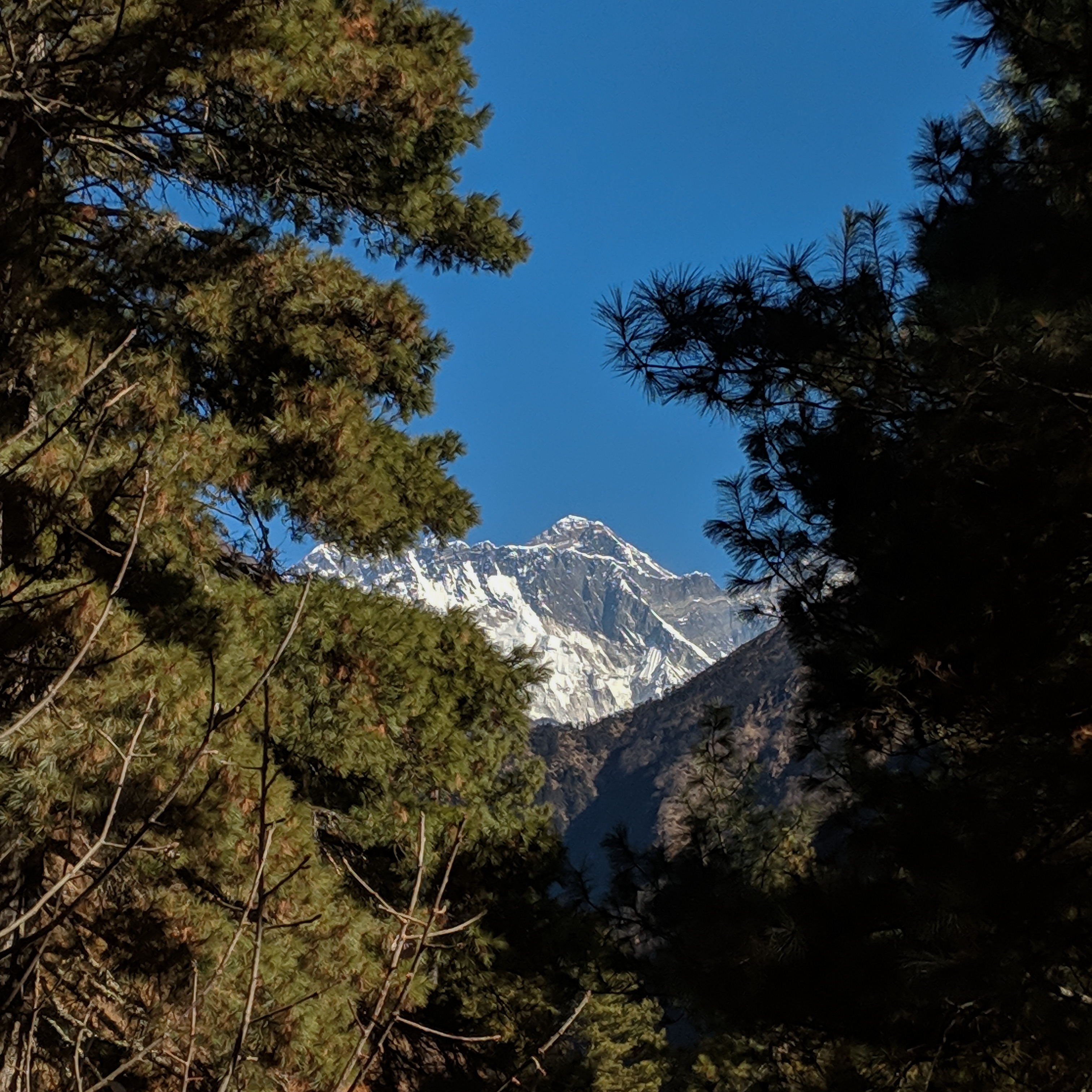 We had a little respite at this viewpoint with the first glimpse of Everest. In fact this was probably the best view of Everest that we ever got.
As you get closer to the Base Camp, Everest gets obscured by the mighty Lohtse and Nuptse.
We had a little respite at this viewpoint with the first glimpse of Everest. In fact this was probably the best view of Everest that we ever got.
As you get closer to the Base Camp, Everest gets obscured by the mighty Lohtse and Nuptse.
Getting into Namche the city is steep and the YMH lodge was at the end of the town and the last few hundred meters are just a straight up climb on steep stairs through the city.
Namche Bazaar is a big trading post when traders in the past used to travel from Tibet to Nepal to trade salt. Now it is the last major settlement before the tea house leg of the
journey begins and the glamping ends.
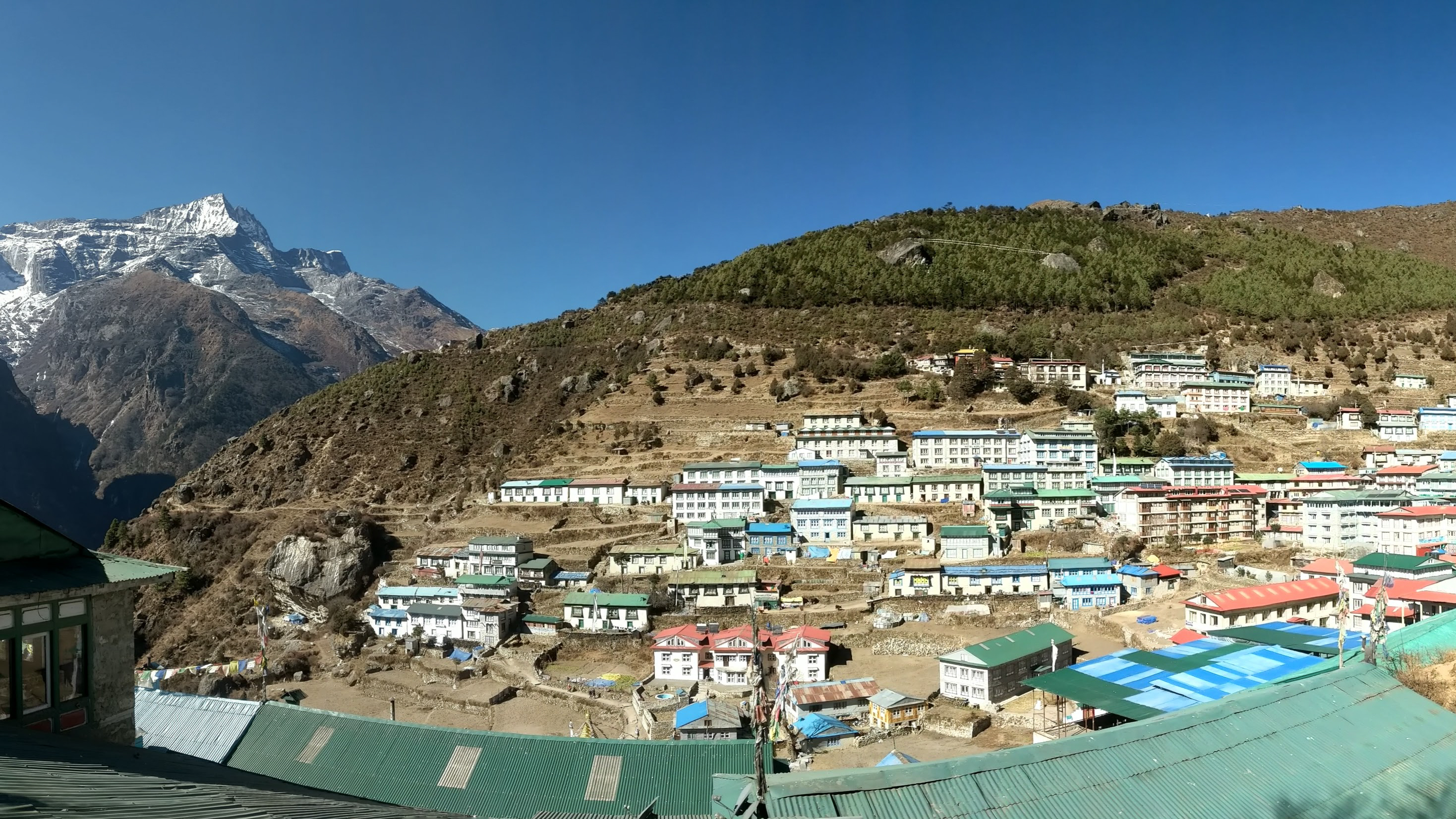 The little town sits in a bowl like valley with the Kongde range visible from every angle. We had beautiful views of the range and the city from our room.
The little town sits in a bowl like valley with the Kongde range visible from every angle. We had beautiful views of the range and the city from our room.
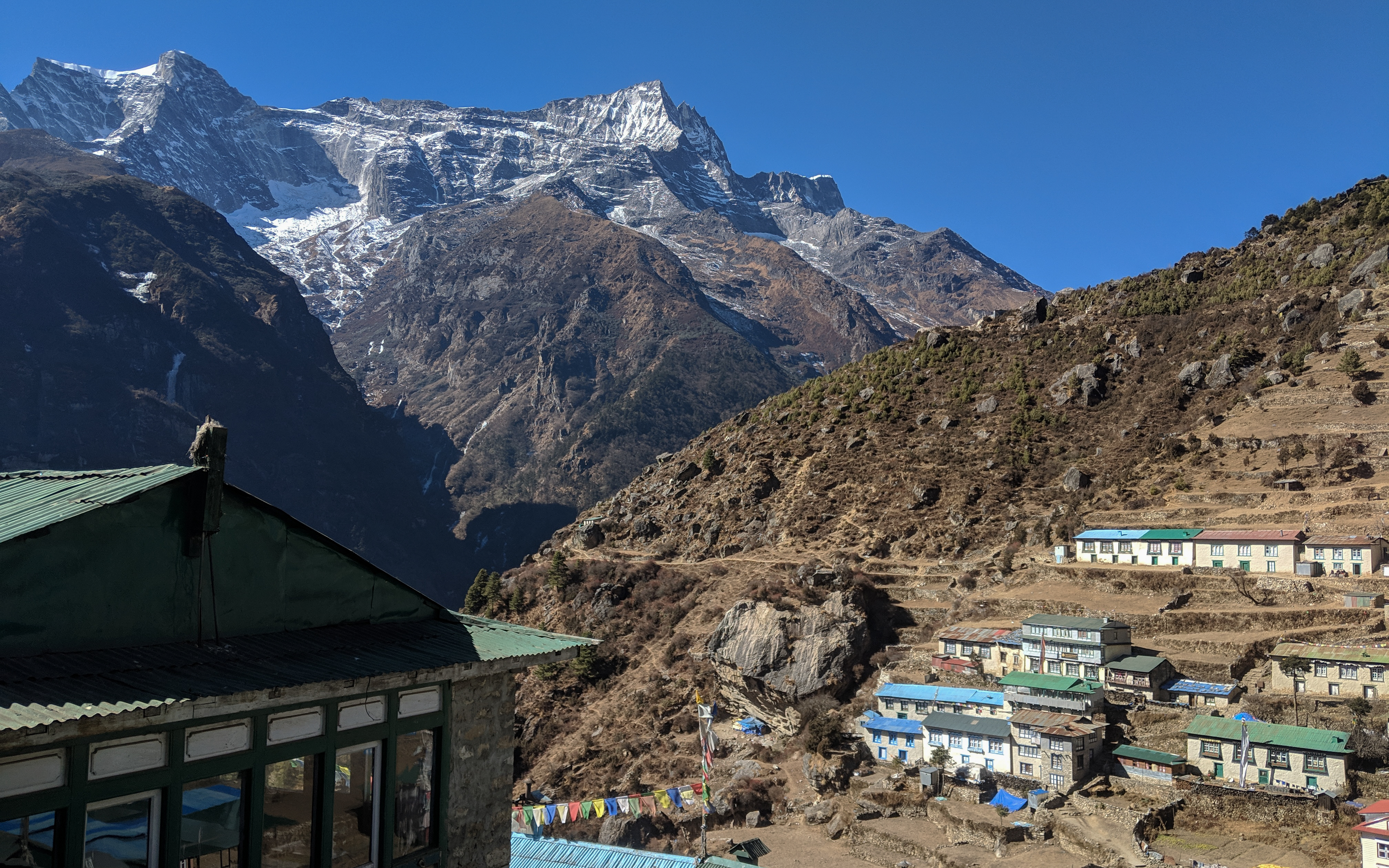 We took this opportunity to shower in Namche and it felt awesome even though the shower water was heated by solar and the water did not stay warm for very long. YMH has a great library and sunroom.
As we showered and settled down into the room, clouds rolled in. Dinner was Dal, Bhat and some boiled vegetables and chicken. Today Tanzing introduced us to some amazing chili and garlic dip.
Apparently, Sherpas used to carry crushed garlic, ginger and chili to avoid sickness in the mountains and stay warm.
We took this opportunity to shower in Namche and it felt awesome even though the shower water was heated by solar and the water did not stay warm for very long. YMH has a great library and sunroom.
As we showered and settled down into the room, clouds rolled in. Dinner was Dal, Bhat and some boiled vegetables and chicken. Today Tanzing introduced us to some amazing chili and garlic dip.
Apparently, Sherpas used to carry crushed garlic, ginger and chili to avoid sickness in the mountains and stay warm.